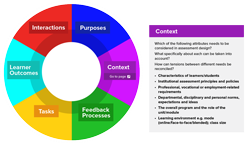This framework helps university teachers make good decisions about assessment design. The six categories draw from existing evidence on good assessment, and data from a study of Australian university assessment practices.
The framework identifies the key considerations in assessment design, including the effects of assessment on learning. It is also available to download as a PDF. For detailed exploration of each category please refer to the Guide.
Purposes of assessment
How can assessment: (1) support student learning; (2) generate grades that will form part of subsequent certification; and (3) equip learners in making future judgements?
Contexts of assessment
Which of the following attributes needs to be considered in assessment design? What specifically about each can be taken into account? How can tensions between different needs be reconciled?
- characteristics of learners/students
- institutional assessment principles and policies
- professional, vocational or employment-related requirements
- departmental, disciplinary and personal norms, expectations and ideas
- overall program and role of the unit/module
- learning environment, e.g. class size or mode (online/face-to-face/blended).
Learner outcomes
How does assessment align with, and promote, desired student outcomes, including: (1) unit/module learning outcomes; (2) overall program learning outcomes; (3) professional requirements; and (4) students’ general professional or intellectual development.
Tasks
Students need to engage with a range of tasks to: (1) develop and (2) demonstrate their learning.
- What is the rationale for each task?
- How do the tasks drive learning? What do the tasks specifically require learners to do?
- How will successful completion be judged?
- How are tasks best distributed across the semester?
- How will students contribute?
- Which tasks will be graded?
Feedback processes
- How are multiple feedback opportunities achieved through the distribution and relationship of tasks across the unit/module/overall program?
- What types of feedback information will be provided and by whom?
- How will learner performance be used to influence the (re)design of later tasks?
Interactions
- How will resistance or engagement from learners or colleagues influence assessment processes?
- How will learners understand what is required in the assessment task(s)?
- What information will be needed to improve this assessment for subsequent occasions?
- What associated changes in teaching and learning activities will be required?


